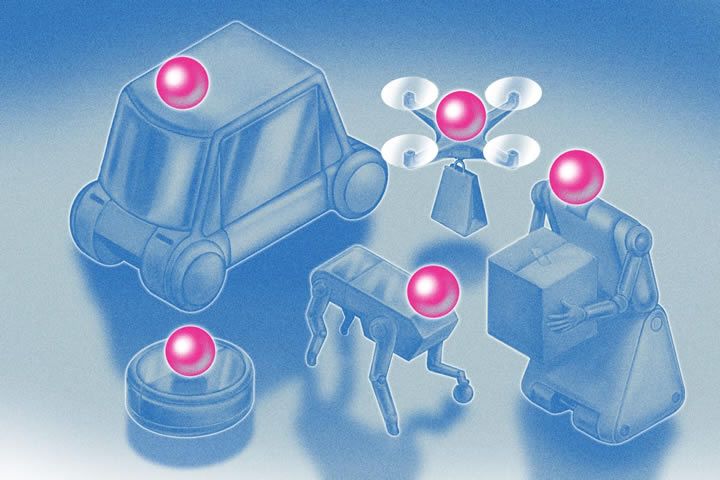The next era of robotics and AI won't be defined solely by technical breakthroughs but by how well these systems integrate into human environments. No matter how powerful the sensors or how technical the learning models are, without user trust, adoption will stall.
 The Missing Interface: Designing Trust into a Robotic Future
The Missing Interface: Designing Trust into a Robotic Future

Matt McElvogue, VP of Design | Teague
Faced with the unknown, distrust of technological disruption is a natural response. History is full of skepticism toward transformative innovations. In the 1860s, when the first automobiles appeared on British roads, lawmakers didn't just set a speed limit of 2mph; they required a person to walk ahead waving a red flag. This reaction from society to disruption and our instinct to regulate what we don’t yet understand recurs with every major technological leap, from steam engines to smartphones.
Today, humanoid robots like Tesla's Optimus and Boston Dynamics' Atlas are moving closer to real-world deployment, with companies aiming to bring them into the workplace—and eventually our homes. While they’re not household fixtures just yet, the long-term vision is quickly taking shape, resulting in the same familiar tension between innovation and apprehension towards the unfamiliar.
These aren’t minor upgrades to how we live and work. They’re full-scale shifts in human-machine interaction, arriving faster than we can emotionally or cognitively adapt. But here’s the critical insight: user distrust often points to unaddressed design gaps.
The Trust Deficit in Robotics
Among emerging technologies, humanoid robots have one of the steepest uphill climbs when it comes to earning trust. Unlike other machines, they carry the burden of resemblance—looking almost human, but not quite. The uncanny valley, that psychological discomfort we feel when something looks a little too lifelike without being convincingly so, is very real. The humanoid design of today’s robots inspires curiosity, but also an undeniable eeriness.
Robots are also difficult to read. Humans are experts at interpreting intent through tone, body language, and social cues. Robots, powered by AI and wrapped in metal casings, give us none of that. Without transparent signaling about what they’re perceiving or why they’re acting, they can feel unpredictable and even threatening.
Physical presence adds to the intimidation. Many robots are large, heavy, and powerful. When something that strong moves near a human without obvious intention or communication, fear is a rational reaction. We don’t know how to interact with them, especially when they're in workspaces or homes - environments traditionally dominated and inhabited solely by humans.
Compounding this is a deeper psychological discomfort: perceived obsolescence. When robots operate in roles historically held by people, it can feel not just like automation, but like replacement. The fear isn’t only “Will this robot hurt me?” It’s also, “Will this robot replace me?”
That’s the perennial challenge of all new tech: lack of shared experience. When people don’t have a frame of reference for how something works or what it feels like to use, it takes much
longer to normalize. Without access, experience, or understanding, a trust gap naturally emerges.
Trust Isn’t Engineered. It’s Designed.
If we want to bring robotics into the mainstream and our streets, homes, and workplaces then we must design for trust. It isn’t an afterthought; it must be a central pillar from day one, evolving as we introduce new technology.
Through our work in robotics, AI, and autonomy, we've identified three essential ingredients for designing trust into autonomous systems: Safety, Confidence, and Control.
Safety: The Foundation of Trust
Safety is more than a technical metric. It’s a feeling, and one that varies from person to person and moment to moment.
For an autonomous robot, being safe isn’t enough. It must also look, feel, and emphasize safety. This is where visibility becomes crucial. A humanoid robot sharing a space with people should telegraph its movements before it makes them. Its behavior should be legible. Just as a driver uses turn signals or a dog wags its tail, robots must evolve their own language of intent for human understanding.
In contexts like autonomous vehicles or public mobility aids, safety becomes even more nuanced. A solo traveler late at night will have different expectations from someone commuting midday. Design systems must be responsive, adaptable, and capable of understanding individual thresholds for safety.
Confidence: The Trust You Build Over Time
Trust is also about predictability. People want to know: Will this robot or AI do what I expect it to? And if it doesn’t, will I understand why?
Confidence grows through repeated, reliable interactions, but it also depends on transparency. We need systems that “narrate” their logic not in arcane technical jargon, but in human-readable ways. This isn’t just about debugging or user support. It’s about building a dialogue between humans and machines.
When AI explains how it arrived at a decision or gives users the option to steer its choices, it transforms from a black box into a partner. That partnership is essential if we’re going to accept AI and robots as collaborators in our work and personal lives.
Control: The Power to Intervene
Autonomy, by definition, reduces direct human input. But that doesn’t mean removing human agency.
Users must always feel like they have recourse. That doesn’t mean slapping an emergency stop button on every machine but instead, designing intuitive, accessible override systems that restore a sense of authority when needed. In factories, that might be a manual mode for delicate or high-stakes operations. In an autonomous vehicle, it could be the ability to change course or pause without needing a manual.
Even the option of control can foster trust. Autonomous airport wheelchairs may not need manual steering, but including a joystick, even if rarely used, reassures users.
As robots join the myriad of other tools found in the workplace, they’ll need to clearly communicate how humans can intervene when safety and costly material is on the line. These new relationships demand new ways of thinking about user experience (UX) and responsibility.
Trust is the Missing Interface
The next era of robotics and AI won’t be defined solely by technical breakthroughs but by how well these systems integrate into human environments.
No matter how powerful the sensors or how technical the learning models are, without user trust, adoption will stall. And without adoption, feedback loops break down, iteration slows, and innovation ultimately suffers.
Instead, UX must be elevated from an afterthought to a strategic priority. UX goes beyond the look and feel of an interface. It’s about designing systems that make sense, feel safe, and invite participation. Companies should prioritize trust-driven design: testing with real users early, refining safety protocols, and ensuring intuitive control mechanisms.
Without the focus, even the most advanced robots will idle at 2mph, trapped behind society’s red flags. But with trust as the foundation, we can unlock a future where humans and machines collaborate seamlessly.
The content & opinions in this article are the author’s and do not necessarily represent the views of RoboticsTomorrow
Featured Product

